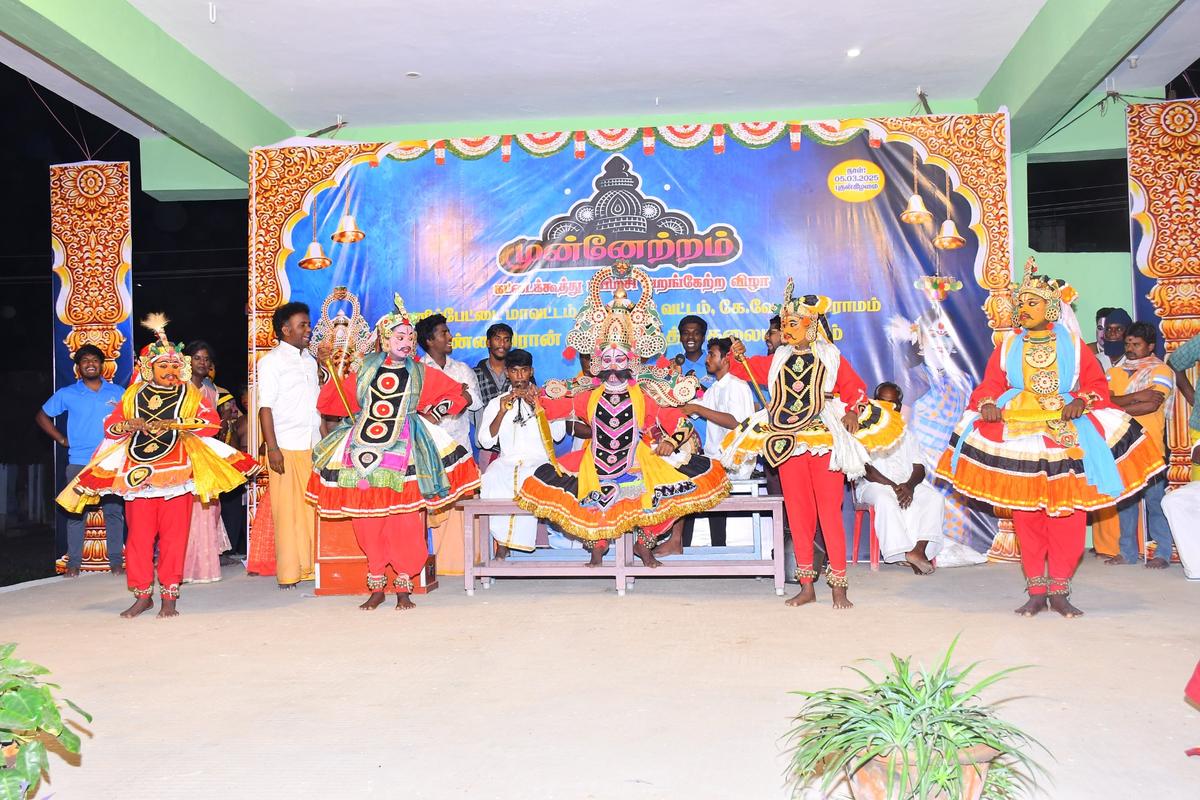From Munnetram, a night-long event that bridged the divide between art forms
K. Velur village, Arcot taluk, Ranipet district, recently bustled with youthful energy, kindred spirits and pride. The stage near the Uthiragiri Amman temple in the village, with two statues dedicated to Kalavai Ponnusami and Tamil scholar Prof. M. Varadarasan, speaks of the village’s long-term involvement in their heritage of Koothu and Tamil.
The village hosted the Munnetram (Progress) project of Kattaikkuttu training programme in three villages in the surrounding area, sharing the shortened versions of their new koothu along with Carnatic music (Ashwath and team), Bharatanatyam (Sangeeta Isvaran and Mookambikai trained girls of Katradi Centre in Kalavai village) and multiple folk forms (Nanbarkal team from Chennai). The overnight event began at 9 p.m. and lasted till 6.30 a.m. The project was led by Thilagavathi Palani.
Overnight Koothu performances are not new in Northern Tamil Nadu. But the presence of a young audience through the night, the performances of urban and rural groups, the mixing of classical and folk forms and the inclusive caste and gender dynamics were certainly refreshing.

Munnetram turned K. Velur village into a stage for artistic experiment
Though we think that breaking the fault lines of the urban-rural divide in the performing arts in Tamil Nadu is a recent phenomenon, it actually has its own unique history.
When culture in India is becoming homogenised, the home-grown artistes’ growing desire to critically engage with their art forms is heartening. This engagement has been crucial in bringing about change in the contemporary context — of being rooted yet accessible.
Village leader Nandakumar was happy that a Carnatic music concert was staged for the first time there. While the mangalavadhyam (nagaswaram and thavil, three of each) featured a female artiste, the North Chennai-based Nanbarkal group led by Deepan included school and college students and employed people; they performed Parai, Silambam, Karagam, Poikkaalkuthirai and Mayilattam.
Deepan shared how these art forms were livelihood options and skills to entertain and create awareness for members of the group.
The three Koothu performances -— Pudheri Pillaivakkam (trained by A. Kandeepan), Veliya Nallur (taught by Arimuthu aka Babu) and K. Velur led by Thilagavathi herself — at the night-long event also highlighted the effort to erase the socio-cultural divide. The stories performed were Vilvalaippu / Draupathi’s Marriage, Saindhavan Garva Bangam and Karna Moksham. Mythology was employed to establish a connect with the audience. The purpose was to make them think through familiar stories.
The culmination of a three-month long training, the first Koothu group had a total of 24 artistes in the age group of seven to 18. Kandeepan mentions how almost 50 of them came for the audition. The second group had a mix of professional artistes and students. Karna Moksham was performed by a mixed gender group by predominantly Dalit youth.
While most of the trainers and musicians in all the three villages studied together at P. Rajagopal’s Kattaikkuttu Gurukulam, many of the younger artistes have been working with Thilagavathy at Shri Krishna Kattaikkuttu Kuzhu. “Though it could be laborious, I am passionate about training young enthusiasts. We need them to take this movement forward. It’s a rewarding experience because they come with their own set of new ideas and approaches,” says Thilagavathy. She had been dreaming of this project for three years. Educationist Prema Rangachari of Bhuvana Foundation helped crystallise it.
Way back in the 1980s, the Madras Craft Foundation initiated the introduction of folk forms in Chennai schools. Scholar and writer V.R. Devika worked on it for almost a decade. In 1990, Rajagopal and his wife Hanne de Bruin started the residential koothu training gurukulam at Punjarasanthangal. They admitted boys and girls from different caste groups. In fact, Thilagavathi is one the first graduates of the gurukulam. However, the sustenance of the school is becoming increasingly difficult with no State recognition or funding.
Thilagavathi, who broke new grounds as a woman koothu artiste, has been reaching out to women and encouraging them to use the art form to better their lives. In this journey, she is often joined by trained Bharatanatyam dancer Sangeetha Eswaran, whose NGO Katradi works on bringing about social and cultural interventions through arts.
Art can change how communities are perceived. In that sense, Munnetram was more than a performative event, it removed the barriers to progress.
Published – March 26, 2025 02:51 pm IST
